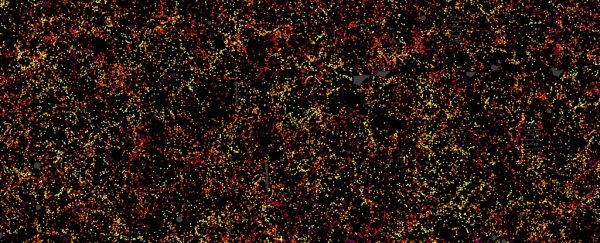It took hundreds of physicists and astronomers five years to construct this image, which is the largest-ever, most precise, three-dimensional map of distant galaxies that charts the dark energy propelling the accelerated expansion of the Universe.
Project co-leader Jeremy Tinker from New York University said: "We have spent five years collecting measurements of 1.2 million galaxies over one quarter of the sky to map out the structure of the Universe over a volume of 650 cubic billion light years."
The results of the project have been published in the Monthly Notices of the Royal Astronomical Society. "This map has allowed us to make the best measurements yet of the effects of dark energy in the expansion of the Universe. We are making our results and map available to the world," Tinker adds.
Consistent with the calculations of general relativity, the galaxies were observed drifting towards areas of the Universe with more matter - thus more gravitational pull.
Shirley Ho, an astrophysicist at Berkeley Lab and Carnegie Mellon University (CMU) who co-led two of the companion papers says the data they gathered will pave the way towards more accurate measurements: "We can now measure how much the galaxies and stars cluster together as a function of time to such an accuracy we can test General Relativity at cosmological scales," she said.
 Daniel Eisenstein and SDSS-III
Daniel Eisenstein and SDSS-III
On top of the fact that we currently do not know what exactly dark energy and dark matter are, the team also had to decipher between the two in their measurements. Thanks to the Baryon Oscillation Spectroscopic Survey (BOSS) program of the Sloan Digital Sky Survey-III, measurement of the rate at which the Universe expands was made possible, which led them to measure the amount of dark matter and dark energy which our present Universe is made of.
By determining the size of the baryonic acoustic oscillations (BAO) in the three-dimensional distribution of galaxies, BOSS can measure the expansion rate of the Universe. Galaxy distribution was measured starting from 13.7996 billion years ago, 400,000 years from the time the Universe is believed to have started — a time when pressure waves are known to have travelled throughout the cosmos.
From that point on, astronomers were able to observe the competition between dark matter and dark energy in controlling the Universe's expansion.
"We've made the largest map for studying the 95 percent of the Universe that is dark," said David Schlegel, astrophysicist at Lawrence Berkeley National Laboratory (Berkeley Lab) and principal investigator for BOSS.
"In this map, we can see galaxies being gravitationally pulled towards other galaxies by dark matter. And on much larger scales, we see the effect of dark energy ripping the Universe apart."
Rita Tojeiro of the University of St Andrews in Scotland, who co-led the BOSS galaxy clustering working group alongside Tinker outlines how this is a milestone for cosmology:
"We see a dramatic connection between the sound wave imprints seen in the cosmic microwave background 400,000 years after the Big Bang to the clustering of galaxies 7-12 billion years later. The ability to observe a single well-modelled physical effect from recombination until today is a great boon for cosmology."
"The results from BOSS provide a solid foundation for even more precise future BAO measurements, such as those we expect from the Dark Energy Spectroscopic Instrument (DESI)," said Natalie Roe, Physics Division director at Berkeley Lab.
"DESI will construct a more detailed three-dimensional map in a volume of space ten times larger to precisely characterise dark energy — and ultimately the future of our Universe."
This article was originally published by Futurism. Read the original.
